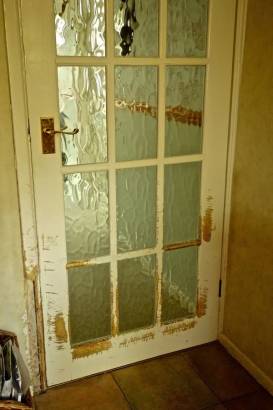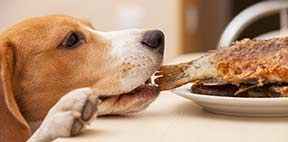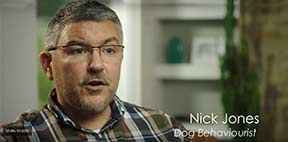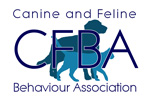Chewing and destructive behaviour in puppies and older dogs can result from a number of issues that may need addressing, but more often than not, we either have an immature dog relieving sore gums which is an entirely natural behaviour, or a dog that is being left alone for too long without adequate stimulation. Destructive behaviour can also be the result of high-stress levels in the home that affect your dog. Chewing and destructive behaviour can also be attributed to separation anxiety. I shall set out the individual reasons why your dog may be chewing and destructive in this article.
Chewing is an entirely natural behaviour in most cases, and many dogs will thoroughly enjoy a bone on the lawn or a Kong stuffed with the dog’s favourite food. This natural behaviour gives your dog the chance to act in a very primal way and to chew on the bones to release the inner goodness that can be found inside. I touch on this area early on, as providing your dog with an opportunity to chew in a constructive way on an item that is healthy for your dog and that provides a great mental and physical outlet, is bound to put things in your favour should you find that your dog is showing destructive behaviour or chewing items in the home that you do not want it to chew.
Why Do Dogs Chew When Left Alone?
As I often explain to my customers in my dog behaviour visits, you can only address behaviours if you’re present and if you can’t be present then we need to think on how you can prevent your dog from causing damage to your home in your absence. Let’s start by breaking down all the various types of chewing that you might be experiencing and then as we progress, we can look at constructive ways on how you can set about overcoming the chewing and destructive behaviour.
Why Do Puppies Chew?
Puppies like to explore the world through their senses and taking items in their mouths and testing textures, flavours and densities is a basic approach for gaining a greater understanding of its environment.
In the first few months of puppy-hood, they experience the emergence of the 28 puppy teeth and at about four months of age (depending on the breed) they will begin to be replaced with 42 adult teeth, which include the molars and is usually settled down by six months of age. There is a lot going on in the canine’s jaw in their first six months and assuming you get your puppy at 8 weeks of age, you will be there for a full four-month period of sore gums and the basic need to relieve that soreness and to chew!
How to Stop a Puppy From Chewing Everything
You can expect to have to cope with puppy chewing for the first six months. Whilst the need to chew is a basic one and it should be allowed on appropriate items, it is also important to ensure that your puppy understands that chewing on your hand or on your clothing is not acceptable, as you will not want this to continue into adulthood for obvious reasons. I have written an article on the subject of biting and nipping problems which can be read here. https://alphadogbehaviour.co.uk/post/biting-and-nipping-problems-with-dogs
Providing a young dog with a good supply of puppy chews is an essential way to navigate through the teething period in puppies. Items such as chilled dog chews, strong rags that have been twisted and frozen can all help your puppy through this stage.
I have raised numerous puppies in my own home and they have all come through that rearing process with an absolute bear minimum of damage to the home and certainly never anything that caused damage or financial loss to mention. 'How' you ask? I use a crate from day one of bringing the puppy home. We are strict in that if the puppy cannot be supervised for a time, it is placed inside the crate with appropriate bedding, water and chew things and left there as we carry out other chores. The crate is used at night with the door closed and for short, sensible periods in the daytime also, including daytime sleeps. Between us as a family, the puppy is never left for long periods in the crate in the daytime.
Why Do Adult Dogs Chew When Left Alone?
Understanding why adult dogs chew is not quite so straightforward and a little detective work may be required to establish the most likely cause or causes. Puppies are relatively easy to address in comparison, as we can understand the most common reasons and solutions as set out above.
So let’s look at the most common reasons that you can expect an older dog to chew or become destructive in the home.
Destructive Behaviour and Separation Anxiety
Although all dog behaviours should be assessed by an experienced dog behaviour specialist, this is the primary reason for a dog chewing excessively or destructive behaviour in your absence once past the age of 9-12 months. Even puppies can suffer from separation anxiety, especially separation anxiety at night, but this behaviour can be more apparent in dogs as they settle into an adult routine. Separation anxiety in dogs can be triggered by changes in the home such as a new baby, an adult starting back to work or changing work hours or the loss or addition of another dog or person in the household. Some dogs have a greater propensity towards displaying behaviours that fall under the banner of separation anxiety and so they may need to be managed in a way that helps set the dog up to feel secure and positively distracted when left alone.
As this article is not solely focussing on the separation anxiety condition, I shall avoid going into great depth on the subject here as it warrants its own article, but I shall look at some basic ways to help address this to get you moving in the right direction as sometimes a few basic tools can make all the difference. There is currently a short page on my website covering the subject that is due for a comprehensive re-write in the coming months. https://alphadogbehaviour.co.uk/post/separation-anxiety-in-dogs
In the absence of an in-depth article discussing this at present, allow me to briefly set out the areas that you can have an influence upon with regard to destructive behaviour and separation anxiety. There are numerous products that can make life easier when seeking to change destructive and chewing behaviours and so I shall set those out for you that link through to Amazon. I am familiar with all these products first hand and have been recommending them for many years now. For simplicity, I have created a shopping list at the foot of this page for you.
- Make departures and homecomings super calm and collected. Once home, fully ignore your dog until it calm enough to sit and gently be stroked by you using a soothing voice.
- Bring your dog off the sofa and bed at night. This is in an effort to create some emotional and physical space between you. I would then (depending on the dog’s behaviour) re-allow these measures later on…say, after a three month period.
- Prevent your dog from following you and being your shadow. It iOS okay for a dog to be with you as you move to different areas in the home, but if you can’t make a cup of tea or make a trip to the bathroom without your dog being by side your side, he’s likely to be overtly anxious as to your whereabouts. Work on the Sit and Stay command and close doors behind you as you leave the room.
- Starting with short periods initially, provide your dog with a stuffed Kong filled with a customised moist mixture of healthy food, or I will often suggest that the owner changes brands of dog food so that the dog can work for its daily allowance of a moist brand of food called Forthglade that is highly nutritious and dogs usually love it. 3, 4, 5 or 6 mini sessions like this each day can help the dog become accustomed to being left alone and a positive experience in the process. I would usually build a complex programme for the owner at this stage and so this is where you may like to contact me so we can work together on the programme suited to you and your dog.
- Finally, I will often use a little method that I call ‘Rapid Returns’, whereby you leave the dog in a room for a minute (this increases gradually) and then return, being sure to blank the dog as you re-enter the room each time. Over the repeated sessions you should see the dog’s reaction upon your return becoming more relaxed and less stressed. When used correctly, this is an extremely effective method that greatly increases the number of short times your dog experiences being left alone and as a result, can fast-track the process of being more relaxed when left alone.
The above is a bit of a divergence in some respects, but you are likely to be reading this article due to damage in the home by an older dog and separation anxiety is likely to be the main reason for that damage, hence the above methods I set out to help get you moving in the right direction.
Destructive Behaviour and Boredom
Although many dogs can cope when left alone for sensible periods of time, a dog that is under-exercised and under stimulated can still resort to destructive behaviours in the home and chewing is likely to be a result of that ‘lack’ in the dog’s time left alone.
Exercise requirements vary greatly depending on the breed and age, but it’s not unusual for me to advise that an owner aims to double the amount of exercise their dog is currently receiving, simply because it’s already falling short by a half in the first place. There really is a wide variation on requirements, but most dogs of 12 months and upwards that are capable of running and cavorting, will take an hour of off-lead exercise per day as they mix with other dogs and people. Some dogs may not be getting off lead due to a lack of recall or maybe is not sociable with other dogs, but if that’s the case, contact me ask that we can address that behaviour first before progressing to other areas. A long (30-50’) training line can often allow the exercise to be given whilst retaining the control levels should this be the case for you.
How to Stop a Dog From Chewing Everything
Once you have addressed the subject of exercise, you can then go on to look at what access your dog has to certain parts of the home so as to quickly illuminate damage in certain locations and then to have a think on some simple ways in which you can keep your dog busy and distracted when left alone.
Very often, I find that owners are giving too much freedom to their dogs when they are out and provided that the dog is exercised, fed and watered, we would then hope that the dog would curl up and sleep for a large section of the time the dog is left alone. There is no need to allow a dog upstairs when you leave the home or to give access to the lounge. If the dog is completely free from behaviour problems, then I don’t have an issue with it, but when you have a dog that is chewing and being destructive in your absence, I would aim to close down the options and possibilities for damage in the home. A kitchen and hallway should be enough, provided that it’s warm, dry, light and has a comfortable bed. Naturally, this might vary depending on your home and layout.
I personally think that a dog should not be left alone for more than four hours. After this point, the dog will usually need a break and so you may need to consider a dog walking service or a friend to drop in and to allow a toilet break and to replenish the food distraction items before you return home. A big run before being left should be given if this is happening regularly for you and your dog.
The Use of Food to Cope With Destructive Behaviour in Dogs
Given that many dogs I see are food motivated, this would often be my first port of call when seeking to create additional mental and physical release in a dog in the home when alone. This can sometimes be described as ‘environment enrichment’.
- Assuming your dog is kept indoors when you’re out (most would be in my experience) I would consider items such as Kongs that can be stuffed with a tasty recipe and then one, two or more can be placed on the floor for the dog. If you know he will eat them from frozen, then I advise that approach to slow him down a bit.
- If feeding dry food, you can look at the Kong Wobbler which I like a great deal and also the food cube is a long standing favourite and tends to move about more.
- Dogs can be allowed to chew on items such as chicken and duck wings from as young as 10 weeks of age. This is a useful guide to what bones you can expect to give your dog at the various ages.
- If you would rather not give your dog a bone, then there a wide range of devices on the market that can still provide all the mental and physical focus that a meaty bone might, but you will need to think about what type of fillings would be enjoyed and are appropriate for your dog.
- Please ensure that you supervise your dog should it be left with a bone of any nature. However, I have always felt it safe to leave a dog with a suitable sized Kong and filling.
- Bones can’t be too big, but they can be too small. Match the bone to the dog.
- If your dog breaks off small pieces of bone, I recommend removing them.
- Separate dogs when feeding raw bones, The sense of competition can cause possessive behaviours and possibly lead to aggressive behaviour.
- As with human food, be sure you can trace the source of the bones. Ideally, bones that are sourced from organic, pasture raised or grass fed animals ensure that they are of the right nutritional profile and free from additives in the food chain.
- Destructive behaviour can normally be quickly resolved with a little detective work and some common sense around management of the dog.
Dog Mental Stimulation
Other than food to keep your dog busy in your absence, you can also look into other activities that you could take part in with your dog when you are together as it will all help feed into draining those energy banks in readiness for being left alone and to further help avoid destructive behaviour or chewing in your absence. An excellent book that I have been recommending for a good few years is called ‘Brain Games for Dogs’ and can be found on Amazon here. It will offer you many smart ideas to keep your dog occupied when you’re present and when the dog is left alone. Also to add to the interactive and stimulating activities your dog carries out each day and week, think about activities that can take places in clubs such as agility, flyball, gundog classes, tracking classes, herding, sledge pulling and so on. Ideal for specific breeds that are designed for such activities.
Before leaving your dog alone, you will need to make reasonable efforts to lift up out of the way items you don’t want your dog to gain access to. This could be anything from the TV remote to your slippers and shoes or tea towels and so on. You should also consider removing waste bins out of your dog’s reach as they can be upturned and are the source of fascination for at least an hour, along with laundry, both clean and dirty. Dogs love to try and sort it into light and darks, but I’ve yet to see a dog get it right. On a more serious note, I’ve met with numerous owners that have had to pay for expensive operations to remove dishcloths from their pet’s stomach, so do dog proof your home before leaving and try not to have unrealistic expectations of what is on or off limits for your dog if you think it could become bored when left alone.
When it All Goes Wrong
Let’s assume for a moment that you do come home to damage or a mess. What do you do? The answer is NOTHING, apart from putting your dog outside whilst you clear up the mess. Reprimanding your dog for an action that was free from malicious intent (he didn’t do it to spite you or to teach you not to leave him alone) would not be an inappropriate way of dealing with it, although I can understand your frustration at his actions. It simply means that you will need to re-read this document to see where things may be falling down and to start from there. I’m here to help, so feel free to contact me via my online form to see what can be done.
10 of the Best Items to Help Overcome Destructive and Chewing Behaviours
As promised here is the shopping list of items personally sourced on Amazon that can greatly help when a dog is destructive or chewing in the home as well as addressing areas of separation anxiety, as the condition tends to be so tightly woven into this issue.
The excellent book - Brain Games for Dogs.
The equally excellent book - Brain Games for Puppies.
Zylkene for dogs. A natural, protein-based calming remedy. Check the size of the dog before ordering.
Kong Classic. Perfect for stuffing with moist food. X-Small to 2X-Large.
Kong Wobbler. Perfect for food driven dogs on dried food.
LickiMat for dogs. If you've not seen these, well just get one! Peanut butter for dogs too!
Snuffling mat. Perfect to forage in and machine washable too.
Grannick's bitter apple spray. The best and original. Discourages chewing and biting of items.








